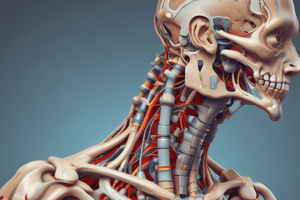Podcast
Questions and Answers
What are the three main types of muscles?
What are the three main types of muscles?
Skeletal muscles, Smooth muscles, Cardiac muscles
How many bones are there in the adult human body?
How many bones are there in the adult human body?
206 bones
What is the primary function of smooth muscles?
What is the primary function of smooth muscles?
Contract involuntarily, helping regulate processes like digestion and blood flow
What is the role of joints in the musculoskeletal system?
What is the role of joints in the musculoskeletal system?
What is the role of ligaments in synovial joints?
What is the role of ligaments in synovial joints?
What do tendons connect to in the musculoskeletal system?
What do tendons connect to in the musculoskeletal system?
What is the function of cartilage in joints and bone ends?
What is the function of cartilage in joints and bone ends?
What are the components of bones that give them their strength and flexibility?
What are the components of bones that give them their strength and flexibility?
What enables humans to move in a variety of ways?
What enables humans to move in a variety of ways?
In maintaining physiological balance and homeostasis, what role does the musculoskeletal system play?
In maintaining physiological balance and homeostasis, what role does the musculoskeletal system play?
Study Notes
The Musculoskeletal System: An In-Depth Exploration of Muscles, Anatomy, Bones, and Movement
This comprehensive article delves into the fascinating world of the musculoskeletal system, focusing on the essential components of muscles, anatomy, bones, and the critical role they play in movement.
Muscles
Muscles are the dynamic elements of the human body, which enable movement, maintain posture, and facilitate various other activities. They are composed of numerous individual fibers, known as myofibers, that contract and relax to generate force. There are three main muscle types:
- Skeletal muscles: These muscles are attached to bones and contract voluntarily, allowing us to control our movements.
- Smooth muscles: These muscles are found in internal organs and contract involuntarily, helping regulate processes like digestion and blood flow.
- Cardiac muscles: These muscles make up the heart and function involuntarily, pumping blood throughout the body.
Anatomy
The musculoskeletal system is a symphony of bones, muscles, and joints that work together to provide stability and mobility.
- Bones: There are 206 bones in the adult human body. They provide structural support, protect internal organs, and serve as attachment sites for muscles to generate movement.
- Joints: These are the areas where bones meet and connect. Joints can be classified as fibrous, cartilaginous, or synovial, depending on the composition of their connecting tissues. Synovial joints are the most common and allow for the widest range of motion.
- Ligaments: These fibrous bands connect bones to other bones, providing stability to joints.
- Tendons: These are the fibrous bands that connect muscles to bones. They transmit the force generated by muscle contractions to create movement.
- Cartilage: This flexible connective tissue lines joints and bone ends, reducing friction and providing cushioning.
Bones
Bones are essential in providing structural support and facilitating movement. They are composed of calcium phosphate and collagen, giving them their strength and flexibility. Bones contain blood vessels, nerves, and bone marrow, an important site of blood cell production.
Movement
The musculoskeletal system enables humans to move in a variety of ways. Muscles contract, and bones slide past each other in a joint, creating movement. The coordinated efforts of muscles and bones result in a wide range of possible movements, including flexion, extension, rotation, and angulation.
Physiological balance and homeostasis
The musculoskeletal system plays a critical role in maintaining physiological balance and homeostasis. For example, the body's center of mass is constantly shifting with movement, so the system must constantly adjust to maintain balance.
Conclusion
The musculoskeletal system is a complex and fascinating part of the human body. It is responsible for movement, stability, and support. By understanding the role of muscles, anatomy, bones, and the coordinated movement between them, we can better appreciate the wonders of our physiological systems and strive for healthier living.
Studying That Suits You
Use AI to generate personalized quizzes and flashcards to suit your learning preferences.
Description
Explore the components and functions of the musculoskeletal system, including muscles, bones, anatomy, and movement. Understand the roles of muscles, bones, joints, and the physiological balance they maintain.




